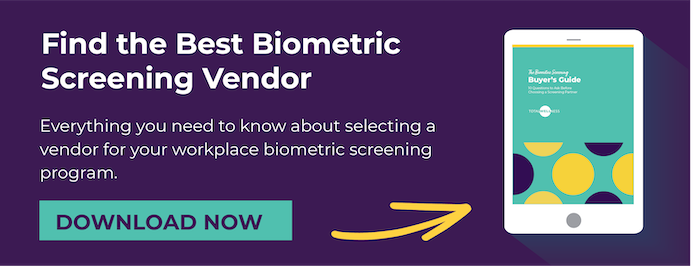 So you’ve heard all the recent talk about cholesterol, but what does it really mean? Cholesterol can affect your health on a number of levels, but it’s important to learn what cholesterol is, how it affects your body, and what you can do about it. Cholesterol can help to predict the health of your employees, and is a signifier of a lot of potential health problems, so allow us to explain.
So you’ve heard all the recent talk about cholesterol, but what does it really mean? Cholesterol can affect your health on a number of levels, but it’s important to learn what cholesterol is, how it affects your body, and what you can do about it. Cholesterol can help to predict the health of your employees, and is a signifier of a lot of potential health problems, so allow us to explain.
What is cholesterol?
Cholesterol is a waxy substance that can come from our bodies and from the food we eat. In our bodies, it’s made primarily by our livers, but when it comes to food, cholesterol is often found in meat, poultry and full-fat dairy products.
Some of the confusion comes from the fact that there are good and bad types of cholesterol. They’re named based on the type of lipoprotein that carries the cholesterol to and from the cells in your body.
LDL Cholesterol is the bad cholesterol. It contributes to plaque, which is a thick, hard deposit that can build up in your arteries. This can clog them and make them less flexible, which makes it more difficult for blood to flow throughout your body and can put you at risk for dangerous blood clots.
HDL Cholesterol is the good cholesterol. It helps to remove the LDL cholesterol from your arteries by carrying it back to your liver. This can help to protect you from the negative side effects of LDL cholesterol build up.
Triglycerides can also affect your cholesterol level. These are another type of fat that’s used to store the extra energy you get from your diet. People with high triglyceride levels often have a higher total cholesterol level, which includes increased LDL and HDL cholesterols. Together, LDL and HDL cholesterol, and a portion of your triglyceride count make up your total cholesterol.
How does cholesterol affect your health?
Cholesterol can’t dissolve into your blood like a lot of the healthy substances you eat. If it isn’t transported throughout your bloodstream properly, it builds up, which creates the plaque we talked about earlier.
The damaged arteries are a huge risk factor to developing coronary heart disease or having a heart attack or stroke. Essentially, damaging your arteries puts your whole circulatory system out of whack. Your blood can’t flow properly, which leads to the more serious outcomes that can affect your heart.
What does that mean for your employees wellness program?
Cholesterol can be a sign of a potential negative health outcomes, so it’s important to keep an eye on it. Cholesterol is a relatively easy test that can be done at any health screening event, and you have the best chance to maintain your health if you catch rising cholesterol levels early.
In fact, living for years with high cholesterol greatly increases your risk for heart disease. For this reason, it’s important to test cholesterol even in younger individuals. If we wait until people are in their 50s and 60s, it might be too late.
Testing cholesterol levels at your biometric screenings can help your employees to adjust their lifestyle and lower cholesterol before they get to that point. As the employer, you’ll also get an aggregate data report. If you see a trend of high cholesterol in your workforce, you have an opportunity to target that in the wellness activities you sponsor and promote.
What wellness activities will affect cholesterol?
There are a ton of things you can do to lower cholesterol levels before they take a toll on your heart health. In general, eating a healthier diet and getting regular exercise are great steps towards lower cholesterol and better health in general.
Some excellent options you can present within your program include:
Supporitve work environment: Create a culture that empowers and supports employees in their efforts to lose weight. Ideas include on-site programs, healthy potlucks (try a smoothie bar or trail mix bar) stress relief stations, and group goal setting to build social support. Losing as little as 5 to 10 percent of body weight can help to significantly reduce cholesterol levels.
Eating a heart-healthy diet: Many people don’t know the ins and outs of a heart-healthy diet. Providing recipe books, cooking demonstrations or simple educational fliers can help your workforce gain that knowledge. Some tips to a heart-healthy diet include:
- Choosing healthier fats
- Eliminating trans fats
- Limiting the cholesterol you take in from your food
- Selecting whole grains
- Eating lots of fruits and veggies
- Seeking out foods rich in omega-3 fatty acids
Exercise consistently: Exercise can reduce cholesterol levels in everyone—no matter their weight. It can also increase the level of HDL (good) cholesterol in your body. If you can, workout for at least 30 minutes every day. These workouts can be completely relevant to you. Choose something you enjoy whether it’s swimming, biking, chasing the kids around the yard, playing in recreational sports leagues or any type of activity that raises your heart rate.
You have a great opportunity as a wellness manager to sponsor and promote these types of exercise events. Consider forming a sports league for your employees, organizing a team to train for a race or even walking over your lunch breaks.
Cholesterol might seem like a hot topic as of late, but it doesn’t have to be overwhelming. Manage your cholesterol, and help your employees do the same, by knowing what cholesterol is and addressing it in your corporate wellness program.
Do you have any other questions about the role of cholesterol in wellness?


